There are worse things in the world than lake effect snow and the polar vortex, but it’s hard to imagine what they might be when you’re driving from Hartland, Wis., to Comstock Park, Mich., to survey the damage that fire can wreak on a baseball stadium in the coldest winter in nearly thirty years.
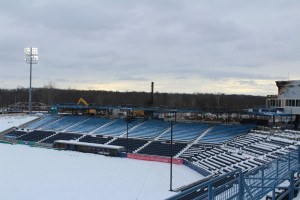
Sparked by a heater in a luxury suite, the fire at Fifth Third Ballpark—home to the West Michigan Whitecaps, the Detroit Tigers’ Class A Minor League affiliate—started on the morning of January 3, 2014, and destroyed virtually everything on the park’s first-base side, including concessions, locker rooms and luxury skyboxes. The fire also caused extensive smoke and water damage to the areas behind home plate and third base. I wasn’t the closest adjuster to the stadium, but my specialty is large losses and this definitely qualified. More important, there are not many adjusters who have the experience rebuilding a devastated baseball stadium.
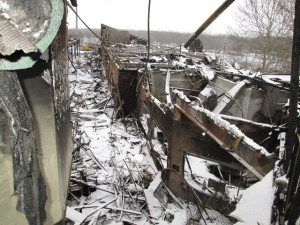
More than a decade ago, when another stadium was under construction, a strong wind gust brought down a million-pound right-field panel that had been suspended from a large crane, destroying part of the stadium and delaying the opening of the ballpark by a year. I’d been the claims adjuster on that case, and as I drove through white-out conditions en route to Michigan, I doubted that the Whitecaps could afford to wait that long. I also had my doubts about getting to Comstock Park in one piece, as darkness fell over I-94, now a sheet of ice. The drive should have taken me five hours; instead, I arrived in Comstock after eight hours of the most harrowing conditions I’ve ever encountered.
The next morning I sat down with the agent, claims manger and account executive from the Whitecaps’ broker, USI Insurance Services, as well as representatives from Wolverine Construction, who had built the stadium and would be working on its repair as well, and the entire senior Whitecaps management team.
Whitecaps CFO Denny Baxter informed me that the team was facing two milestones—opening day on April 8 and the 50th-anniversary Midwest League All-Star Game on June 17—and he was unequivocal that both had to be met. That would give us three months to get the stadium operational, a challenge even in good weather and close to impossible in a mean winter. I knew that the only way we could reach those milestones was if everyone involved, from the construction crews to the Whitecaps’ management, could completely align our efforts and work like a proverbial well-oiled machine. Clark Benton, USI’s agent on the job, was confident that would happen. “I’ve never seen a team assembled as quickly and as well,” he told me. “Within the first couple of meetings, it was pretty obvious that everyone involved was of such a high caliber that they were going to figure it out.”
To help accelerate the process, Chubb quickly cut a check, making a commitment that we would do everything possible to have them up and running in time for opening day. We also retained a construction consultant, J. Murphy, whose job was to coordinate all the resources necessary to pull off the near-impossible. For six weeks, Murphy was on site, nearly full-time meeting with Wolverine and Belfor Restoration (the construction firm the Whitecaps hired to tackle the areas of the stadium that hadn’t suffered significant structural damage) and their subcontractors. He collaborated with the Whitecaps and their architect, and generally helped us all get our arms around this monumental endeavor.
Recently, Murphy reflected on the hurdles he and Wolverine faced. They were up against both time—a painfully short deadline—and temperature. “There was no heat in the building and, of course, no heat outside,” he remembered. “And for most of the time until the beginning of April, the workers were doing their jobs in temperatures approaching zero, and sometimes below.” The problem wasn’t just the discomfort of the workers. Concrete contains water, and when the water freezes, the concrete doesn’t set. To overcome that stumbling block, Chubb paid to reroute existing gas lines so natural gas could flow to a series of heaters installed throughout the stadium. “We had to become creative,” Murphy said.
It also took creativity to stick to the schedule. Murphy was able to coordinate the construction crews so that they could move seamlessly from one job to another without down time. Under his guidance, Belfor’s interior crews finished their work on the third-base and home-plate sections just as Wolverine’s exterior crews completed work on the first-base side; this allowed Wolverine’s crews to start work immediately on the final interior restoration of the first-base side.
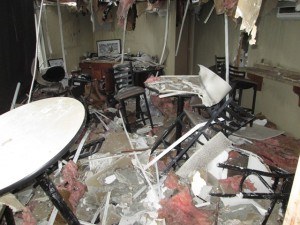
And work they did: Half of the stadium was so badly damaged from the fire that it had to be completely demolished and rebuilt from scratch. The half that suffered only smoke and water damage nevertheless needed new flooring, drywall, insulation and cabinetry. And everything that didn’t have to be pulled out and replaced required cleaning and spray-sealing with an expandable polymer to eliminate smoke smudge, soot and odor.
Since Wolverine had never had to deal with fire damage before, Chubb hired Wiss, Janney, Elstner (WJE) to provide forensic engineering. Their expertise allowed them not just to identify potential problems but also to help Wolverine quickly resolve those problems and stay on schedule. WJE’s engineers knew, for example, how structural steel is affected when exposed to high temperatures and were able to determine which steel members could be reused and which required replacing.
Because so much of the stadium had been destroyed, Chubb also brought in and paid for the services of New York-based Accurate Inventory & Salvage Corporation to help the Whitecaps determine what contents needed to be replaced. Over a three-day period, Accurate Inventory’s president, Ian Fischer, sat down individually with the team’s department heads. In order to jog the memories of people who were already reeling from the shock of the fire, he sketched out pictures of the destroyed portions of the stadium. Meanwhile, two other employees from his firm walked through the damaged areas and made a list of the items they could see that needed to be replaced.
The process was ongoing: “I told all the members of the Whitecaps organization to keep sending me information, invoices, proposals—anything they could find,” Fischer told me. “Everything came to me directly, and I stayed in personal communication with everyone.”
He was able to provide the Whitecaps with a highly detailed list that included dimensions, model numbers, and other essentials of everything from ice cream freezers and a $10,000 beer system to computers and specialized audio-visual equipment to seating, banners, tents, and mascot uniforms. With the list in hand, they were able to order their replacement property quickly so that it would be in place come opening day.
And then there was the electronic billboard. Set between the stadium and the surrounding highway, it was the Whitecaps’ lifeline to the public, but smoke and water damage had rendered it inoperable. Now, drivers passing by had no way of knowing when—or even whether—the stadium was reopening, unless they thought to go to the team’s website. So one of our priorities was to get the board working again ASAP. To do that, we got two local contractors working on it almost immediately, and it was back in action within two weeks.
From the billboard specialists to the forensic engineers to the folks who provided the Whitecaps with a new and improved beer system, the job at Fifth Third Stadium was a massive collaborative effort requiring careful coordination and an influx of up-front money, both of which Chubb provided. The team of experts working on the stadium was unparalleled, but the real stars of the effort were the Whitecaps themselves, who made their goals clear from day one. Because they knew I’d had experience with another stadium loss, they were confident in our ability to get the job done and more than willing to work with us. Their reward—and ours—was a perfect opening day. By April 8, the entire stadium, with the exception of the interiors of the luxury boxes, had been completely rebuilt, and there was no evidence of the fire that had gutted it three months earlier.
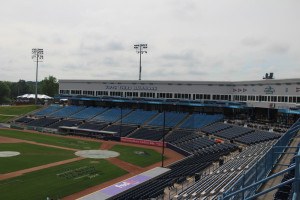
And on the evening of June 17, the all-star game came off without a hitch. Fans in the stands and the newly rebuilt luxury skyboxes cheered on the players; the mascots in their new costumes revved up the crowd; and the Whitecaps’ managing partner and CEO, Lew Chamberlin, received the League’s Presidential Lifetime Award for getting the stadium up and running again so quickly. I doubt any of us involved in the repair have been as happy (and relieved) to hear the words “Play ball!” as we were that day.
Looking back to the not too distant past, Chamberlin recalled, “Chubb really helped us out by getting us access to the site within days. Usually after such a large claim like this, there are investigations by various parties who may have some exposure — and this process can take weeks, if not months.”
Steve Mortensen is an executive general adjuster for the Chubb Group of Insurance Companies.
Was this article valuable?
Here are more articles you may enjoy.

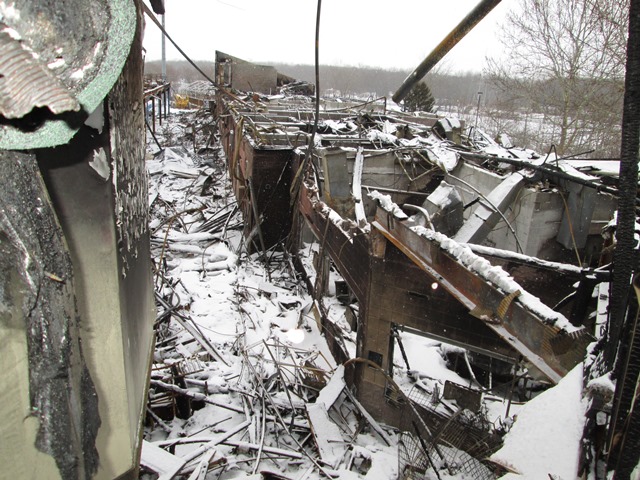
 Congo Sues Apple Alleging ‘Pillaged’ Minerals in Products
Congo Sues Apple Alleging ‘Pillaged’ Minerals in Products  CVS Accused of Illegal Opioid Dispensing in Whistleblower Suit
CVS Accused of Illegal Opioid Dispensing in Whistleblower Suit  Uber Warns NYC Response to Insolvent Insurer Exposes Drivers
Uber Warns NYC Response to Insolvent Insurer Exposes Drivers  US House Task Force Releases ‘Blueprint’ for Federal AI Responsibility
US House Task Force Releases ‘Blueprint’ for Federal AI Responsibility 